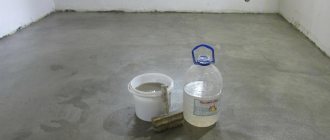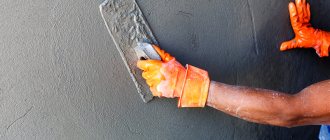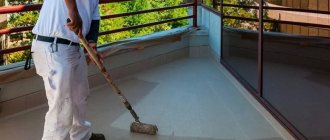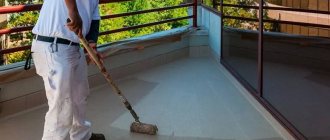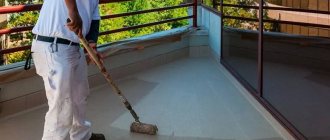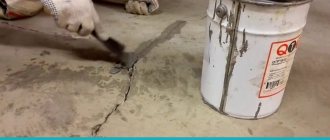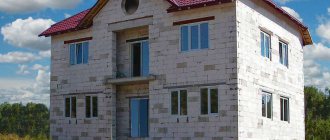Liquid glass has another name - silicate glue. It is used as an additional component in the building mixture to impart special qualities to the composition. Thanks to the coating using silicate glass, the surface becomes resistant to fungal attack. Water-repellent and fire-resistant properties also appear. This building material is used as a protective layer, but at the same time gives an aesthetic appearance to the coating.
Due to its composition, liquid glass does not absorb moisture. This reduces the risk of deformation and subsequent destruction of the surface Source garant-beton-gbi.ru
Advantages of liquid glass
The main component of the composition is sodium silicate. It is this substance that prevents moisture from penetrating into the treated surface. Silicate glass is produced mainly in the form of a viscous liquid, which is mixed with cement. The combination of these building materials significantly reduces the period of work. A solution with sodium silicate hardens much faster. The polymerization process occurs when interacting with carbon dioxide, i.e. in the fresh air the mass will harden many times faster.
Depending on the composition, silicate is used to coat concrete or wood. The mixture is indispensable as plaster due to its protective properties against negative environmental influences Source odstroy.ru
The main advantages of liquid glass:
- Consistency. The silicate solution is able to penetrate into small cracks and depressions. This increases the durability of the coating.
- Creates a protective layer in the form of a thin film. The method and time of application of the composition does not play a fundamental role. In any case, the surface will have a solid film coating.
- Reduced material consumption. Liquid glass increases the volume of the solution, and effective filling of the porous surface does not allow overuse of building material.
- Budget savings. The main component of mortar is cement. This is an inexpensive material that is one of the most accessible on the construction market. Liquid glass, with all its characteristics, also has a low cost. Thus, when mixing two components with minimal costs, a large volume of high-quality material is obtained.
The low price of liquid glass is combined with the unique properties of the material. This makes it the most popular in the repair industry Source msk.transmosbeton.ru
Books on the topic:
Concrete mixtures. Recipe guide for builders and manufacturers of building materials - P. Mayorov - 166 rubles - link to book review
Composites based on dispersed reinforced concrete. Questions of theory and design, technology, structures - Felix Rabinovich - 1,988 rubles - link to review of the book Additives in Concrete - V. Ramachandran - 1,475 rubles - link to review of the book
Chemistry of cement and binders - Evgeniy Shmitko - RUB 1,183 - link to book review
Sawdust is a by-product, a waste product from wood processing.
Therefore, their sizes and shape of particles are not specified, but are known to a certain extent - as a property of the tool used to saw solid wood.
They insulate walls (frame most often than others), floors, ceilings and basements of low-rise buildings with sawdust and materials based on them.
Properties of silicate composition
Coating the base with liquid glass gives it a number of additional properties:
- Increase in hydrophobic indicators. This is especially true for structures that regularly come into contact with liquid. A coating with the addition of liquid glass is ideal for swimming pools, basement buildings with the possibility of penetration of atmospheric precipitation and similar structures.
- Accelerated hardening. When covering the base with a standard cement-sand mortar, it will take up to five days for it to completely harden. Adding liquid glass reduces this period to a day.
- Increased waterproofing. Silicate material has antiseptic properties. Its use does not allow fungi and bacteria to multiply in the coating area. This is why surfaces treated with silicate glass are protected from mold.
- Increased heat resistance. Resistance to elevated temperatures for ordinary cement mortar is determined by 200 degrees. This means that if this indicator is exceeded, the base is deformed. The presence of sodium silicate in the solution increases the heat resistance. In this version, the coating can withstand temperatures above 1500 degrees. The use of such a mixture is in demand in the construction of stoves and fireplaces.
Gypsum dry-free putty:
You need to repeat everything the same as in the previous version: mix gypsum with lime, and prepare a mixture of resin and liquid glass. After that, both compositions need to be mixed and sand and kerosene are added, and then simply bring the putty to the required thickness.
| Substance | Parts |
| Seeded gypsum | 5 |
| Seeded fluff lime | 0,2 |
| Fine sand | 2,3 |
| Wood resin | 2,4 |
| Liquid glass | 0,1 |
| Kerosene | 0,5 |
Area of application of the material
The composition is used for various types of construction work:
- Production of concrete blocks with special technical characteristics: fire resistance, frost resistance, acid resistance.
- Production of plaster with hydrophobic properties.
- Waterproofing when laying the foundation.
- Waterproofing of walls of basements and basements.
- Construction of swimming pools and wells.
- Construction of fireplaces and stoves.
Waterproofing the foundations of buildings is important in the presence of groundwater. However, even in a more favorable area, additional protection from moisture is necessary, which can destroy the foundation Source martand.ru
Safety precautions
Liquid glass is not a substance with a high level of toxicity. But if the material gets on the skin or mucous membranes, it causes irritation. To avoid injury, special equipment should be used during work. clothes, wear special gloves on your hands, and protect your eyes with safety glasses. Premises where construction work is carried out using liquid glass must be constantly ventilated. If it happens that the prepared solution gets on the skin, it is necessary to treat the damaged area with a weak solution of vinegar diluted in clean water.
Proportional ratio
The purpose of liquid glass determines its amount in the solution. For different types of mixture there is a certain ratio of ingredients:
- Hydrophobic plaster: cement - 1 part, sand - 2.5 parts and silicate glue - 15% of the total mass.
- Universal solution: cement - 1 part, sand - 3 parts and liquid glass - 1/5 of the total volume.
- For swimming pools: a mixture of cement and sand in equal proportions - 10 parts, silicate hardener - 1 part.
- Protective coating for wells: all components are mixed in equal parts.
- Heat-resistant coating for furnaces: cement - 1.5 parts, 4 parts sand and 1.5 parts liquid glass.
An insufficient content of silicate glass in the solution will not give the desired effect, and exceeding the norm of liquid glass by more than 25% of the total mass of the solution can lead to cracking of the base. Source skgsk.ru
Preparation of the solution
A responsible approach to preparing material for pouring will ensure good results. When mixing cement-silicate mortar, there is a clear algorithm of actions:
- Clean water is poured into a bucket or basin.
- Liquid glass is added in the required quantity.
- The solution is thoroughly mixed.
- The recommended amount of cement and sand is gradually added. The water should be constantly stirred.
Chalk dry putty:
You need to separately mix chalk with lime and prepare a mixture of resin and liquid glass. After that, both compositions need to be mixed and sand and kerosene are added, and then simply bring the putty to the required thickness.
| Substance | Parts |
| Sifted ground chalk | 5 |
| Sifted fluff lime | 0,3 |
| Fine sand | 2 |
| Liquid glass | 0,3 |
| Wood resin | 2,2 |
| Kerosene | 0,5 |
Waterproofing
Creating a water-repellent coating is a priority when choosing a material for pouring the base. Depending on the area of application of the cement solution and silicate glue, not only the recipe for preparing the mixture and the method of its application changes.
Waterproofing during foundation construction
Protecting the foundation from the negative effects of groundwater is the primary task of builders. When installing the foundation, a silicate solution is applied to the surface twice. This is a coating method of application, which is reliable and durable. After covering the foundation with a silicate solution, a waterproof rolled material is laid on top.
In this case, the waterproofing composition is prepared according to the following proportions:
- For 1 kg of cement add 50 grams of liquid glass.
- For 10 grams of silicate, 150 grams of purified water is required.
Waterproofing for swimming pool
The solution can be applied both from the outside and from the inside of the structure. Before using the silicate mixture, recesses and joints should be locally treated over the entire area of the pool. This will improve the sealing properties.
High-quality treatment with a silicate compound on the outside of the pool will protect the structure from being washed out by groundwater. Internal silicate coating is important due to constant contact with water Source kazan.blizko.ru
Waterproofing well walls
For such a coating, the simplest composition is prepared. All components are mixed in equal parts and diluted with water. By analogy with treating a swimming pool, before applying the solution to the walls of the well, coating defects and joints are first covered with it. Only after detailed processing is the entire working area coated.
Putty for aquariums:
Rosin and wax are mixed and heated in an iron can until slightly foaming, stirring continuously, then the mixture must be cooled to approximately 50 ° C and drying oil is added.
| Substance | Parts |
| Rosin | 10 |
| Beeswax (shavings) | 2 |
| Natural drying oil | 10-15 |
PS: I tried to clearly show and describe non-tricky tips. I hope that at least something is useful to you. But this is not everything that can be imagined, so go ahead and study the site https://bip-mip.com/
- Glowing colors. Making luminous paints with your own hands (part 1) There are substances that glow due to stored energy. Their glow can.
- Do-it-yourself glass glue Currently, there are quite a lot of high-quality adhesives for glass.
- Recipe for making a reusable mold for sculptures If you are planning to give free rein to your creativity and start making.
- Glowing colors. Making luminous paints with your own hands (part 3) Glowing paints are also used to make watch dials, compasses, and fire watches.
- Do-it-yourself sealing waxThe time for letters sealed with sealing wax is long over, now wax seals are used.
Monolithic construction technology
Monolithic construction provides the following advantages compared to the construction of houses from blocks:
- there is no need to make blocks;
- it is possible to build walls of any shape (up to roof slopes);
- There are no cold bridges in the walls through the cement mortar joints.
The disadvantage is the increased consumption of materials for formwork.
Work order
Two layers of roofing felt waterproofing are laid on top of the foundations. With a low base, two to three rows of brickwork are made. Install the formwork. The material for formwork can be lumber, moisture-resistant plywood or steel sheet. When using wooden formwork, its internal surfaces are covered with polyethylene.
The height of the shields should be in the range of 40 - 60 cm. When pouring the first layers on the sides of the foundations, stakes are driven into the soil opposite each other to the entire height of the walls. The panels are wedged between the side surfaces of the foundation (wall) and the stakes and connected to each other by pieces of bars. The stakes located on different sides of the wall are tied together with wire.
After pouring, the bars remain in the walls. They are used for fastening panels when rearranging the formwork, and after completion of construction - for fastening the sheathing under the cladding.
The prepared sawdust concrete is poured into layers 10–15 cm high and compacted thoroughly. Raise the wall 20-30 cm at a time, after which they take a break for 5-7 days. During the setting period, the concrete must be protected from sunlight and rain. Every 40 cm, the walls are reinforced with longitudinally spaced wooden slats or steel mesh. At the corners of the building, reinforcement elements are connected to each other.
After the walls are poured, a belt of timber is placed on top of them, which serves as a support for the roof elements. Walls need to be protected from moisture. To do this, the roof is made with wide overhangs, and the facades are faced in any way. Finishing work is carried out after the building has settled (after 1 - 2 months).
When these measures are carried out, monolithic houses made of sawdust concrete serve for many years. They do not require insulation even in the far north. A 40 cm thick wall made of this material protects against frost of -35 degrees.
Required Tools
It is recommended to apply waterproofing in a layer of several millimeters to 1 cm. It is permissible to use various tools, the choice of which depends on the area and quality of the concrete, and the type of surface being treated. Precast concrete products produced by vibration pressing are denser and are processed with a fur roller or a wide brush with synthetic bristles. Poured foundations and walls are more porous; it is advisable to cover them with a thick layer using a spatula.
To apply GS use:
- Painting gun;
- Spray gun;
- Construction spatula;
- With a brush.
For work you will need special clothing.
It is recommended to apply waterproofing in a layer of several millimeters to 1 cm.

